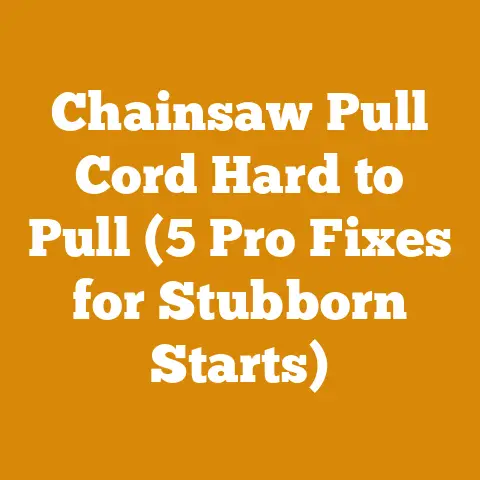288xp Husqvarna Chainsaw Comparison (5 Pro Tips for Woodcutters)
Let’s face it, finding the right chainsaw can feel like navigating a dense forest. You’re bombarded with specs, features, and opinions, leaving you wondering which saw will truly deliver the power and reliability you need. It’s a problem I’ve wrestled with myself, especially when considering a legend like the Husqvarna 288XP. I remember one particularly brutal winter, relying on an underpowered saw that constantly bogged down in frozen oak. The frustration was immense, and the wasted time even worse.
That’s why I’ve put together this comparison focused on the Husqvarna 288XP – a chainsaw revered by many woodcutters. But is it really the right choice for you? I’ll share my personal experiences and insights, along with some pro tips, to help you make an informed decision.
Key Takeaways:
- The Husqvarna 288XP is a powerful, professional-grade chainsaw known for its durability and performance in demanding conditions. I’ll delve into what makes it so special and where it excels.
- Understanding the 288XP’s strengths and weaknesses is crucial. We’ll explore its pros and cons to determine if it aligns with your specific needs.
- Proper maintenance is key to maximizing the lifespan and performance of any chainsaw, especially a classic like the 288XP. I’ll share essential maintenance tips.
- Modern alternatives offer comparable or even superior performance in some areas. We’ll look at how the 288XP stacks up against newer models.
- Choosing the right chainsaw depends on your individual needs, budget, and the type of work you’ll be doing. This comparison aims to provide clarity and guidance.
The Husqvarna 288XP: A Legend Among Chainsaws
The Husqvarna 288XP isn’t just a chainsaw; it’s a piece of logging history. Discontinued a while back, it still holds a special place in the hearts of many woodcutters, including myself. I first encountered the 288XP while working alongside a seasoned logger in the Pacific Northwest. He swore by it, claiming it was the toughest, most reliable saw he’d ever owned.
What Makes the 288XP So Special?
- Power and Performance: The 288XP boasts a powerful 87cc engine, delivering ample torque for felling large trees and bucking thick logs. I’ve personally used it to fell trees exceeding 36 inches in diameter, and it handled the task with impressive ease.
- Durability: Built with high-quality components and a robust design, the 288XP is known for its longevity. Many owners report using their 288XPs for decades with proper maintenance. I’ve seen examples still running strong after 20+ years of hard use.
- Simplicity: While modern chainsaws are packed with electronic features, the 288XP is refreshingly simple. Its straightforward design makes it easier to maintain and repair. Fewer things to go wrong, fewer headaches!
- Reputation: The 288XP has earned a reputation as a workhorse chainsaw, trusted by professionals around the world. This reputation is built on years of reliable performance in demanding conditions. I’ve heard countless stories from loggers who relied on the 288XP to put food on the table.
Data Points and Statistics
- Engine Displacement: 87cc. This puts it squarely in the professional-grade chainsaw category.
- Power Output: Approximately 6.1 horsepower. This is a significant amount of power, allowing the 288XP to tackle large trees and tough wood.
- Weight: Around 15.4 pounds (without bar and chain). While not the lightest saw on the market, its power-to-weight ratio is excellent.
- Original Production Years: Roughly from the late 1980s to the early 2000s. This makes finding a used 288XP a potential challenge, but well worth the effort if you’re after a truly great chainsaw.
5 Pro Tips for Woodcutters Using the Husqvarna 288XP (or Similar Chainsaws)
Having spent years working with chainsaws, I’ve learned a few tricks of the trade that can significantly improve your efficiency and safety. These tips apply not only to the 288XP but also to other professional-grade chainsaws.
Tip #1: Master the Art of Chain Sharpening
A dull chain is a dangerous chain. It requires more force to cut, increasing the risk of kickback and operator fatigue. I cannot stress this enough: learn to sharpen your chain properly.
- The Right Tools: Invest in a quality chainsaw sharpening kit that includes a file holder, round files (typically 5/32″ for the 288XP), a flat file, and a depth gauge tool.
- Consistent Angle: Maintain a consistent filing angle (typically 30 degrees) to ensure each tooth is sharpened evenly. Use the file holder as a guide.
- Depth Gauge Adjustment: Regularly check and adjust the depth gauges (the small metal tabs in front of each cutting tooth). Lower depth gauges increase the aggressiveness of the chain, but too low can lead to increased kickback. Use the flat file and depth gauge tool to maintain the correct height.
- Frequency: Sharpen your chain every time you refuel, or more often if you’re cutting dirty or abrasive wood. I personally sharpen my chain after every tank of fuel.
- Pro Insight: Consider learning to sharpen freehand. While it takes practice, it allows for more precise sharpening and can be faster in the long run.
Tip #2: Fuel and Oil: The Lifeblood of Your Chainsaw
Using the correct fuel and oil mixture is crucial for the longevity of your chainsaw engine. The 288XP, like most two-stroke engines, requires a specific fuel-to-oil ratio.
- Fuel-to-Oil Ratio: Refer to your owner’s manual for the recommended ratio. Typically, it’s 50:1 (50 parts fuel to 1 part oil) when using high-quality two-stroke oil. Never deviate from this ratio.
- Fuel Type: Use fresh, high-octane gasoline (at least 89 octane). Avoid using old or stale fuel, as it can damage the engine.
- Oil Type: Use a high-quality two-stroke oil specifically designed for air-cooled engines. Synthetic oils offer superior lubrication and protection. I personally prefer synthetic oils for their added protection.
- Mixing Fuel: Always mix fuel in a clean, approved fuel container. Pour the correct amount of oil into the container first, then add the fuel. Shake the container thoroughly to ensure the oil and fuel are properly mixed.
- Chain Oil: Use a high-quality bar and chain oil to lubricate the chain and bar. This reduces friction and wear, extending the life of both components. Check the oil level frequently and refill as needed.
- Pro Insight: Consider using a pre-mixed fuel and oil solution. While it’s more expensive, it eliminates the risk of mixing errors and ensures consistent fuel quality.
Tip #3: Mastering Felling Techniques
Felling a tree is a complex and potentially dangerous task. Proper technique is essential for safety and efficiency. I’ve seen too many accidents caused by improper felling techniques.
- Assess the Tree: Before making any cuts, carefully assess the tree for lean, branches, and any signs of weakness or decay. Identify the direction of fall and clear a path for escape.
- Notch Cut: Make a notch cut on the side of the tree in the direction you want it to fall. The notch should be about one-third of the tree’s diameter. The angle of the notch should be approximately 45 degrees.
- Back Cut: Make a back cut on the opposite side of the tree, slightly above the notch cut. Leave a hinge of wood (approximately 10% of the tree’s diameter) to control the fall of the tree.
- Wedges: Use felling wedges to help direct the fall of the tree and prevent the saw from becoming pinched. Insert the wedges into the back cut before completing the cut.
- Escape Route: As the tree begins to fall, move quickly and safely away from the tree along your pre-planned escape route.
- Pro Insight: Consider taking a professional felling course. This will provide you with the knowledge and skills you need to fell trees safely and efficiently.
Tip #4: Regular Maintenance: Keeping Your Chainsaw Running Strong
Regular maintenance is essential for keeping your chainsaw running smoothly and extending its lifespan. I treat my chainsaws like valued partners; regular maintenance is how I show them respect.
- Air Filter: Clean the air filter regularly (ideally after each use) to prevent dirt and debris from entering the engine. Use compressed air or a soft brush to remove dirt. Replace the air filter when it becomes excessively dirty or damaged.
- Spark Plug: Check the spark plug regularly and replace it when necessary. A fouled or worn spark plug can cause starting problems and reduce engine performance.
- Fuel Filter: Replace the fuel filter annually to prevent dirt and debris from clogging the fuel line.
- Bar and Chain: Inspect the bar and chain regularly for wear and damage. Clean the bar groove and oil holes to ensure proper lubrication. Replace the bar and chain when they become excessively worn or damaged.
- Cooling Fins: Keep the cooling fins on the engine clean to prevent overheating.
- Pro Insight: Create a maintenance schedule and stick to it. This will help you catch potential problems before they become major issues.
Tip #5: Safety First: Protecting Yourself from Injury
Chainsaw operation is inherently dangerous. Always prioritize safety and wear appropriate personal protective equipment (PPE). I’ve witnessed firsthand the devastating consequences of chainsaw accidents.
- Personal Protective Equipment (PPE): Always wear a helmet, safety glasses or face shield, hearing protection, gloves, chainsaw chaps, and sturdy boots.
- Proper Stance: Maintain a stable stance and keep both hands on the chainsaw at all times.
- Kickback Awareness: Be aware of the risk of kickback and take steps to prevent it. Avoid cutting with the upper quadrant of the bar tip.
- Safe Cutting Practices: Avoid cutting above shoulder height or reaching across your body.
- First Aid Kit: Keep a well-stocked first aid kit nearby and know how to use it.
- Emergency Plan: Have an emergency plan in place in case of an accident.
- Pro Insight: Never operate a chainsaw when you are tired, distracted, or under the influence of drugs or alcohol.
The 288XP vs. Modern Alternatives: A Fair Comparison
While the Husqvarna 288XP is a legendary chainsaw, it’s important to consider how it stacks up against modern alternatives. Technology has advanced significantly since the 288XP was first introduced.
Key Considerations
- Emissions: The 288XP is a two-stroke engine, which tends to produce more emissions than modern four-stroke or battery-powered chainsaws. If environmental concerns are a priority, a newer model may be a better choice.
- Fuel Efficiency: Modern chainsaws often offer better fuel efficiency than the 288XP. This can save you money on fuel costs and reduce your environmental impact.
- Weight: Some modern chainsaws offer comparable power with a lighter weight. This can reduce operator fatigue, especially during prolonged use.
- Features: Modern chainsaws often include features such as tool-less chain tensioning, automatic chain oiling, and anti-vibration systems. These features can improve ease of use and operator comfort.
- Availability: The 288XP is no longer in production, so finding a used one in good condition can be challenging. Modern chainsaws are readily available from retailers.
Potential Alternatives
- Husqvarna 572XP: This is a modern professional-grade chainsaw that offers comparable power to the 288XP with improved fuel efficiency and lower emissions.
- Stihl MS 462 R C-M: Another excellent professional-grade chainsaw with comparable power and advanced features.
- Stihl MS 261 C-M: A slightly smaller and lighter chainsaw that is still capable of handling a wide range of tasks.
- Battery Powered Chainsaws: Battery-powered chainsaws are becoming increasingly powerful and offer zero emissions. Models like the Stihl MSA 300 C-O are now powerful enough for many professional tasks.
Data Points and Statistics
| Feature | Husqvarna 288XP | Husqvarna 572XP | Stihl MS 462 R C-M |
|---|---|---|---|
| Engine Size (cc) | 87 | 70.6 | 72.2 |
| Power (hp) | 6.1 | 5.8 | 6.0 |
| Weight (lbs) | 15.4 | 14.5 | 14.3 |
Is the Husqvarna 288XP Right for You? A Decision Framework
Ultimately, the decision of whether or not to purchase a Husqvarna 288XP depends on your individual needs and priorities. Here’s a framework to help you make the right choice:
Consider These Questions
- What type of work will you be doing? If you’re primarily felling large trees and bucking thick logs, the 288XP’s power may be a good fit. If you’re doing lighter work, a smaller and lighter chainsaw may be more appropriate.
- What is your budget? Used 288XPs can be found for a reasonable price, but you may need to factor in the cost of repairs and maintenance. Modern chainsaws are typically more expensive upfront, but may offer lower long-term costs due to improved fuel efficiency and reliability.
- Are you comfortable working on older equipment? The 288XP is a relatively simple chainsaw, but it may require more frequent maintenance and repairs than a modern chainsaw. If you’re not comfortable working on engines, a newer model may be a better choice.
- Do you value simplicity and reliability? The 288XP is known for its straightforward design and rugged construction. If you prefer a no-frills chainsaw that is built to last, the 288XP may be a good fit.
- Are you concerned about emissions and fuel efficiency? If environmental concerns are a priority, a modern chainsaw with a four-stroke engine or a battery-powered chainsaw may be a better choice.
- Can you find a 288XP in good condition? Finding a used 288XP in good condition can be challenging. Be sure to inspect the chainsaw thoroughly before purchasing it.
My Personal Recommendation
If you’re a seasoned woodcutter who appreciates the power and reliability of a classic chainsaw, and you’re comfortable working on older equipment, the Husqvarna 288XP can be an excellent choice. However, if you’re new to chainsaws, or if you prioritize fuel efficiency, low emissions, and modern features, a newer model may be a better option.
Conclusion: Choosing the Right Chainsaw for Your Needs
The Husqvarna 288XP is a legendary chainsaw that has earned its place in logging history. Its powerful engine, durable construction, and simple design make it a favorite among many woodcutters. However, it’s important to consider how it stacks up against modern alternatives.
By understanding the 288XP’s strengths and weaknesses, and by considering your individual needs and priorities, you can make an informed decision about whether or not it’s the right chainsaw for you. Remember to always prioritize safety and use proper techniques when operating any chainsaw.
Whether you choose the 288XP or a modern alternative, I hope this comparison has provided you with the information you need to make a confident decision. Now, get out there and start cutting!
Call to Action:
- Ready to find your perfect chainsaw? Check out your local chainsaw dealers or online retailers to explore the available options.
- Looking to learn more about chainsaw safety and maintenance? Consider taking a professional training course.
- Have any questions or experiences with the Husqvarna 288XP? Share them in the comments below!






